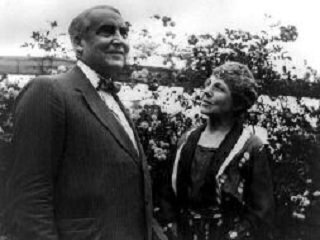On the evening of August 2, 1923, President Warren Harding died in a San Francisco hotel room. Beyond that, the details of the president’s death remained murky for decades amidst rumors of scandal or even worse.
 Today, most historians accept that Harding, 57, died from a heart attack brought on by ample evidence of cardiac problems. But that wasn’t the original cause of death issued in 1923 as rumors soon started flying after the president’s passing. Doctors said in published accounts that Harding died from the effects of a stroke.
Today, most historians accept that Harding, 57, died from a heart attack brought on by ample evidence of cardiac problems. But that wasn’t the original cause of death issued in 1923 as rumors soon started flying after the president’s passing. Doctors said in published accounts that Harding died from the effects of a stroke.
And there was no autopsy done on the body of the president, at his wife’s request.
Dr. Ray Lyman Wilbur, who was also the president of Stanford University, was at the hotel when Harding arrived for treatment, and he recalled the events that followed in his memoirs. “We shall never know exactly the immediate cause of President Harding's death since every effort that was made to secure an autopsy met with complete and final refusal,” he wrote.
Wilbur said an outraged public, upset with the sudden death of a popular president, took out its anger on the doctors.
“We were belabored and attacked by newspapers antagonistic to Harding, and by cranks, quacks, antivivisectionists, nature healers, the Dr. Albert Abrams electronic-diagnosis group, and many others. We were accused of starving the President to death, of feeding him to death, of assisting in slowly poisoning him, and of plying him to death with pills and purgatives. We were accused of being abysmally ignorant, stupid and incompetent, and even of malpractice,” he recalled.
In recent years, historians have been able to read personal papers from the era that shed more light on Harding’s health just before he died while on a presidential trip to the West Coast.
Harding was a popular president who died halfway through his third year in office, just as scandals involving his administration were becoming public.
The decision by Harding’s wife, Florence, to skip an autopsy for her husband, and have his body embalmed one hour after his death, fed the rumor mill in 1923. Later in 1930, a former Harding administration member published a book claiming that Florence Harding poisoned her husband (a rumor that was soon debunked).
The scandals involving Harding kept coming after his death, including claims he had fathered an illegitimate daughter in the White House with his alleged mistress, Nan Britton. The Teapot Dome scandal also consumed much of the early days of the administration of Calvin Coolidge, the vice president who succeeded Harding. Under the Tyler precedent, Coolidge assumed office with the full powers of the President. (The 25th Amendment later made it clear that the vice president became President when the office became vacant under three circumstances: death, resignation, and removal from office.)
There were also scandals involving other government agencies that followed after Harding's death. But it was the multiple stories about Harding’s illness and passing that stirred discussion for decades. Harding hadn’t been in good health when he took off for a West Coast tour that some people saw as a step in laying the groundwork for a 1924 re-election campaign.
Witnesses said Harding didn’t look well during the trip, and that he may have suffered a bout with food poisoning after eating seafood. Harding’s doctors were concerned enough about his health to divert his train to San Francisco. Harding was able to walk off the train into a limousine, which took him to the Palace Hotel.
Doctors huddled over the president for several days. Harding appeared to rally on August 2, but he slumped over in his bed sometime after 7 p.m. and died almost instantly. The initial official cause of death was a stroke, but that has been discounted in recent years.
“It was a heart attack,” said historian Robert Ferrell in a 1996 interview with C-SPAN, discussing his book, “The Strange Deaths of President Harding.” The suddenness of his passing ruled out a stroke, he said.
Ferrell also said there were five doctors at the hotel attending to Harding. It had been determined before Harding’s death that he had an enlarged heart and that he tired easily. One reason the doctors listed a stroke as a cause of death, he said, is that physicians didn’t fully understand heart attack symptoms in the early 1920s.
Another theory, from presidential biographer Carl Anthony, is that Harding’s preferred doctor, Charles Sawyer, gave the president “purgatives” to hasten his recovery. He believes the remedies issued by Sawyer, who wasn’t a trained physician, may have aggravated Harding’s heart condition.
"The evidence makes plausible that (Sawyer) accidentally provoked the death of the president with a final, fatal overdose of his mysterious purgatives," Anthony said in a 1998 interview promoting a book on Florence Harding, "pushing the man's already weakened heart into cardiac arrest."
Scott Bomboy is editor in chief of the National Constitution Center.







